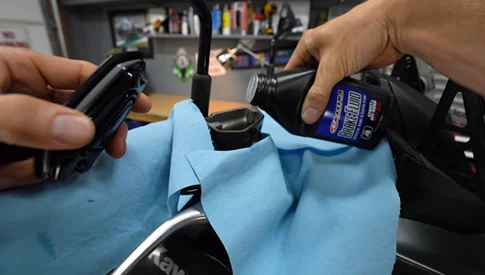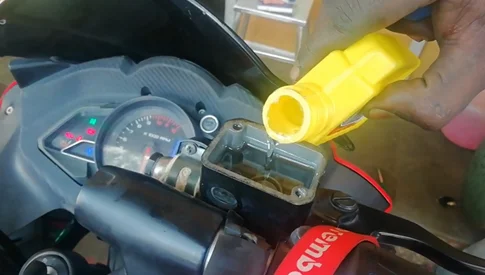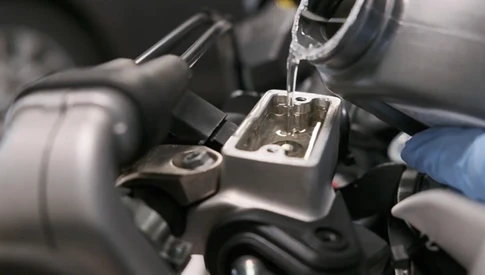Physical Address
304 North Cardinal St.
Dorchester Center, MA 02124
Physical Address
304 North Cardinal St.
Dorchester Center, MA 02124

Break-in oil is a lubricant explicitly designed to be used in new or rebuilt engines. However, unlike regular motor oil, break-in oil is typically thinner than higher-quality synthetic oil. This is because break-in oil is designed to provide a less durable protective oil film than synthetic oil.
The thinner viscosity of break-in oil allows it to flow more easily and reach all engine parts during the critical break-in period. It helps to lubricate the moving parts and reduce friction between them, ensuring a smooth and efficient break-in process.
But that break-in oil isn’t meant to be used for extended periods. Throughout the following article, we’ll explore the suitability of different break-in oil grades and why you should use them. So, keep reading to discover the best oil for your engine’s break-in period.

When choosing a thinner break-in oil grade for your vehicle engine, there are several options to consider.
SAE-30 is a conventional mineral-based motor oil that contains extra extreme pressure additives such as ZDDP (zinc dialkyl dithiophosphate) and/or moly (molybdenum disulfide).
These additives are important during the break-in period because they help reduce friction and wear between the moving parts of the engine. SAE-30 thinner engine oil is specifically designed to provide the necessary lubrication and protection to the engine components during this critical phase.
Note that SAE-30 oil is generally thicker than other break-in oils, which helps create a higher level of protection for the engine.
Multi-viscosity mineral oils (like 5W-30, 15W-40, or 10W-40) are designed to provide excellent lubrication in various temperature conditions.
The first number in the oil’s viscosity rating, such as 5W or 10W, represents its ability to flow at colder temperatures, while the second number, such as 30 or 40, represents its ability to flow at higher temperatures.
This means these thinner oils offer better protection during start-up when the engine is cold and during high-temperature operation.
Using non-detergent SAE-30 lighter oil for engine break-ins is a popular practice among enthusiasts for multiple reasons.
For optimal break-in performance of your vehicle engine, consider using a 15W-40 or similar multi-viscosity diesel oil. Conventional 15W-40 diesel oil is a suitable choice because it contains a higher level of ZDDP (zinc dialkyl dithiophosphate) compared to motor oils designed for gasoline engines.
The higher level of ZDDP in thinner diesel oil provides enhanced lubrication and reduces wear on the engine parts, promoting smoother operation and longer engine life.

During break-in, engines will burn oil as they undergo the crucial process of ring seating. Thinner break-in oil is specially formulated to handle the fine and microscopic debris created during this process. As the rings in the engine cylinder walls begin to seat, small amounts of oil can be consumed.
This oil burning is a normal occurrence during the break-in period and is nothing to be alarmed about. Add only break-in oil to ensure the engine is properly lubricated and protected. The break-in oil is designed to provide optimal lubrication while also allowing the rings to seat properly.
To ensure proper engine seating and protection, it’s recommended to run break-in oil for a specific duration of time. Generally, it’s advised to use thinner break-in motor oil for 500 to 1,000 miles or 10 to 12 full heat cycles.
If opting for the latter, allow the engine to reach full operating temperature and then cool down completely between each cycle. The purpose of running break-in oil is to facilitate the proper seating of the engine components, allowing them to wear and adjust to one another.
However, do not use break-in oil longer than necessary, as its additives are specifically designed for the initial break-in process. Once the engine has been adequately seated, it’s recommended to switch to regular engine oil for ongoing maintenance.
If you neglect to use break-in oil, your engine’s performance and lifespan may be significantly compromised.
Break-in oil is specifically formulated to provide lubrication and protection during the critical break-in period of your engine. Without it, the engine components may experience excessive friction, increasing wear and potential damage.
The absence of thinner break-in oil can result in premature wear of the piston rings, cylinder walls, and other vital components, affecting the overall performance and efficiency of the engine.
Also, the lack of proper lubrication during the break-in period can lead to reduced engine longevity, as the initial wear can set the stage for accelerated wear and potential failures in the future.
Using the right oil during the break-in period of your engine is crucial for optimal performance and longevity. The best oil for this period is a nondetergent or low-detergent oil that contains high ZDDP (Zinc Dialkyl Dithiophosphate) or has been treated with ZDDP concentrate.
This is because ZDDP is a key additive that protects the engine’s metal surfaces during the critical break-in phase. Nondetergent or low-detergent oils are preferred during this period as they minimize the risk of abrasive wear and allow the engine components to seat and wear properly.

SAE-30, with its friction-modifier-free formula, proprietary anti-wear additive package, and excellent film strength, is an ideal break-in oil for your engine. During the break-in period, this oil provides proper lubrication and protection to the engine components.
SAE-30’s friction-modifier-free formula ensures that the rings seat properly, resulting in maximum compression and reduced blow-by. Additionally, the excellent film strength of SAE-30 oil ensures that cams and bearings are protected during the critical break-in phase.
Using the appropriate break-in oil is imperative for the longevity of your engine’s life. While some car enthusiasts prefer thinner oil, others prefer thicker.
Based on the expert recommendations, SAE-30, multi-viscosity oils, SAE-30 non-detergent oil, and 15W-40 diesel oil are great thinner oils for different vehicle engines. However, determining which is right for your engine may require consultation with an expert.
Ultimately, selecting the correct oil viscosity will depend on the make and model of your engine. Whether you choose SAE-30, SAE-30 non-detergent, or other oil, ensure it has the appropriate additives to reduce wear and friction during break-in.